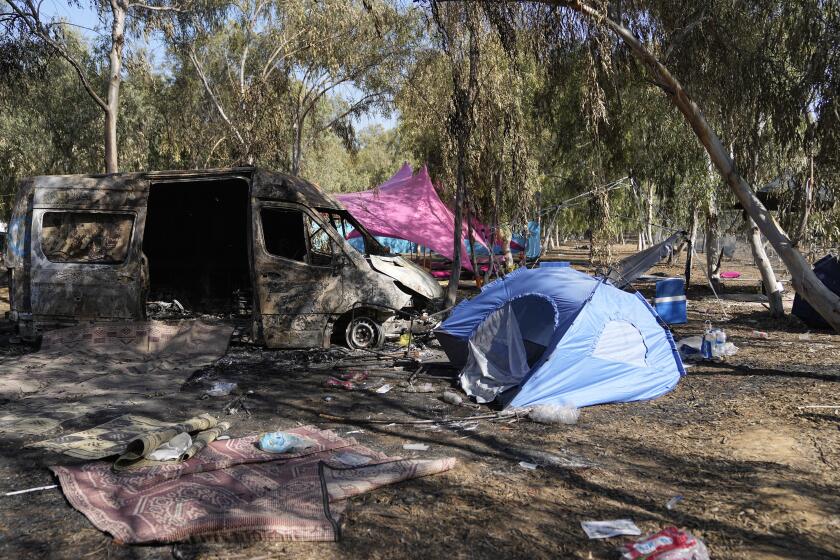Home Safe Home
It is one of life’s most wrenching decisions. As the infirmities of age confront us, do we leave the familiarity and memories of our homes for somewhere more accommodating to wheelchairs, broken hips or illness?
Given a choice, most people would rather remain at home. From that desire has sprung a national “aging in place” movement that helps people adapt their homes to allow them to stay in familiar surroundings, near friends and neighbors, for as long as possible.
Gerontologists estimate that there are at least 1 million older people--and probably many more--living with mobility and health problems and that their ranks will soar as the baby boomer generation begins hitting age 65 in 2011.
Most U.S. homes--the White House included--weren’t built with growing older in mind. President Clinton, once hobbled by a knee injury, was helped by special floor tape to keep him from stumbling again.
“I call this Peter Pan housing,” says Jon Pynoos, director of the Home Modification Action Project at USC’s Andrus Gerontology Center. “Most housing was designed not thinking about anybody who would be disabled or have a chronic condition.”
The front steps, staircases, narrow doorways, low electric sockets, high kitchen cabinets and fixed shower heads that work for young families pose hardships--and hazards--for elders. One in three Americans over 65 suffers a fall each year, often in the home, which can cause serious injury and depression and propel them into a downward slide toward death. Suburban housing developments that promise green lawns and open space sometimes breed isolation once residents’ driving abilities diminish.
A few early studies suggest that some basic home modifications to improve safety and make it easier to maneuver about the home can forestall hospitalization and nursing home care as seniors grow more frail. And the savings that result should be attractive to health care insurers focused on cutting medical spending.
Still, cost and access remain obstacles. Most seniors or their families pay out of pocket for home modifications. And only a well-informed minority discover the scattered government programs that offer financial aid to help people remain in their homes so they can enjoy the comfort of communities where they’ve raised children and paid taxes.
Martha Griswold knows something about improvising to cope with changing physical needs. Born with spina bifida, a spinal cord defect, she obtained master’s degrees in religious education and political science before turning to a career in social work.
Now 69 and executive director of the Living Independently in the Valley Center, she uses her own experiences with disability to help others cope with physical limitations that can lead to a sense of hopelessness.
Crutches helped for most of her life, but in her 50s, she says, “my arm and my stronger leg began to say, ‘I don’t want to do that.’ ” She began using a wheelchair, which meant making some changes at home.
The tan stucco house on a quiet Pasadena street where she and her husband live had one major barrier: a two-step entrance. Griswold’s father, now 91, generously provided the $1,500 to replace the steps with a gently sloped garden pathway, now a showpiece of aesthetics and practicality.
‘I Can Have Guests in Wheelchairs’
The Griswolds, who live modestly, made other unobtrusive changes. They made the drop-off from their driveway to the street more gradual and replaced steps to the back patio with another concrete ramp.
“It means I can invite people over. I can have guests in wheelchairs,” Griswold says.
The biggest expense was the $7,000 they spent to convert a bedroom closet into a small, tiled second bathroom, with a hand-held shower, floor drain and grab bars.
Griswold, a voluble and straightforward woman, understands how physical needs can put a strain on the family. Fiercely independent, she also created a bedside office for herself, equipped with easy-to-reach shelves and a special pullout work surface for typing.
She purchased a used overhead lift to help her get in and out of bed and rely less on her husband, George, a 70-year-old artist who has slowed down himself since having surgery several years ago. The remodeling has made his life more comfortable too. “I had been afraid I would slip in the bathroom,” he said, until he started using the bathroom grab bars installed for his wife and added some nonskid tub strips for himself.
“You do things as they seem necessary,” his wife advises. “A lot of people really only need to get rid of those throw rugs that are tripping them up and find a way to make the bathroom floor not so slippery, or do something about the tub.”
For low-income seniors, local handyman programs, which operate with loans, sliding fees or grants, furnish ramps, stair rails or grab bars that can mean the difference between being driven from home or staying put.
Ask Donna Troupe.
The 66-year-old former bank employee lives alone in an 1,800-square foot, two-bedroom mobile home in Santa Clarita. Worsening rheumatoid arthritis has made her dependent on a wheelchair. But a mobile home, no matter how generously sized its rooms, isn’t wheelchair friendly.
“I could be quite comfortable in a smaller place, but I’ve lived here a long time,” Troupe says. “It’s a nice park and I’d like to stay as long as I can.”
The Santa Clarita Senior Center’s handy-worker program has furnished her with a variety of low-cost alterations. The program supervisor is Frank Pascoe, her daughter Pam’s boyfriend of 25 years.
The program has a $2,000 annual limit for people who meet the qualifications. “That’s not a large amount of money,” Pascoe says, “but we can generally get a wheelchair ramp built for that.”
Troupe got such a ramp, but the 1994 Northridge earthquake “kind of took care of that,” leaving her stranded until neighbors arrived. The handy-worker program replaced the ramp with a used electric lift, widened her bathroom door, took out bedroom doors and put in bathroom grab bars.
Many Put Off Asking for Help
Unlike Troupe, many aging Americans are reluctant to acknowledge their vulnerability or ask for help until their need becomes acute.
“My experience with seniors is that, much more often than not, a decline in physical ability . . . is a sign of kind of throwing in the towel. They’d almost rather put a sharp stick in their eye than install a grab bar,” says Allan J. Browne, president of Extended Home Living Services in Wheeling, Ill. Browne says his clients have spent as little as $100 or as much as $750,000--but generally don’t come calling until an emergency strikes.
Seniors clinging to their independence change their behavior before altering their environment. They’ll stop taking baths because they can no longer climb into the tub. They’ll stop visiting friends because they can no longer manage front stairs. They’ll move into their first-floor dining room because reaching a second-floor bedrooms feels like climbing Mt. Everest.
Approaching them is “very tricky,” says Laura Gitlin, a research sociologist at Thomas Jefferson University in Philadelphia. But once they come to grips with the idea of installing some modifications to make their daily routines easier, the devices get “used a lot,” Gitlin says.
Early research shows such changes do make a difference.
A study in the May-June issue of Archives of Family Medicine found that after 18 months, frail seniors who received intensive services and home adaptations were more independent and experienced less pain than similarly frail seniors who received typical services like home nursing, Meals on Wheels and help with personal care.
Study author William Mann, who runs the Rehabilitation Engineering Research Center on Aging at the State University of New York at Buffalo, says he was particularly struck by the reported reduction in pain. The reasons aren’t clear, but he surmises that the adaptations and devices encouraged independence and activity, which may have distracted the seniors from their discomforts.
The study looked at 104 frail elderly people. Although all declined in health during the study period, those who got intensive services declined less than those who got the common services.
While more money was spent upfront for seniors receiving more intensive services, medical savings were dramatic: an average of $5,630 for their nursing home or hospital care during the study period contrasted with $31,610 in such care for those who got the typical services.
Some of the obstacles to making changes at home stem from the newness of the “aging in place” movement.
A Warning Against Do-It-Yourself Work
Many homeowners looking to make changes aren’t confident they can locate skilled and honest contractors familiar with their special needs--there aren’t many in the business. Gitlin warns against do-it-yourself work because “even something as simple as a grab bar in the bathroom, or a tub bench . . . becomes potentially an unsafe modification if it is not done by a professional.”
Although a few countries--Sweden and Denmark, for example--are advanced in helping their seniors through government-funded programs, federal help in this country is scattershot. Medicaid generally will only pay for “durable medical equipment,” such as walkers. A few states, however, have received special waivers making Medicaid recipients eligible for up to $500 toward home modifications to keep them out of nursing homes.
If you’re poor and elderly, the federal Department of Housing and Urban Development offers subsidized housing, but specially equipped units aren’t always available. HUD’s Home Investment Partnerships Program provides some communities with funds for rehabilitating homes or apartments, but HUD figures show the program’s funds renovated just 5,547 elders’ homes in 1997 and 4,883 last year.
Seniors who have paid off all or most of their home mortgages but may be short on cash may opt for a federally sponsored program that allows them to tap into their home equity and use the loan as they choose. Such a “reverse mortgage” lets them borrow money against the value of their home. Their estate pays off the loan after death.
Pynoos and colleagues here are developing local coalitions of architects, builders, remodelers, hospitals, younger disabled people and the elderly in hopes of creating a national model of cooperation. The Home Modification Action Project is funded by the Archstone Foundation, a Long Beach-based philanthropy focused solely on aging. HMAP has an extensive Web site with information for consumers and professionals as well as a state-by-state compendium of resources.
Seniors Need Advice on Their Particular Needs
Pynoos also has been working with Browne, the Illinois contractor, on a proposed national consulting service for helping the elderly with home adaptation advice and designs. Seniors could contact the service, to be called CASPER (Comprehensive Assessment Survey Protocol for Elderly Residents), and get instructions and plans that a contractor or remodeler in their area could then carry out.
Browne, Mann and other senior advocates stress the need for getting a good, individualized assessment of a person’s needs.
Norman Josephs, a general contractor in Santa Monica, created Rehabitat Inc., to provide a paying clientele with a wide range of home modification products as well as installation and construction. Although a Rehabitat job runs anywhere from $3,500 to $80,000, not all the changes Josephs makes are costly.
He’s established a foundation that takes back the products after residents move from their homes. “We donate that to people who can’t afford it and we do the installation,” Josephs says.
Browne, 52, expects that once people from his generation reach retirement age, having coped with aging parents of their own, they will be “much more open about making changes to accommodate continued independent living . . . because we’ll have had 20 years to get used to the idea.”
(BEGIN TEXT OF INFOBOX / INFOGRAPHIC)
Changes for the Better
As people develop infirmities of age, they may have increasing difficulty getting around their houses. An emerging “aging in place” industry offers modifications, small and large, to help make daily activities easier.
--Compiled by JANE E. ALLEN
More to Read
Start your day right
Sign up for Essential California for news, features and recommendations from the L.A. Times and beyond in your inbox six days a week.
You may occasionally receive promotional content from the Los Angeles Times.






